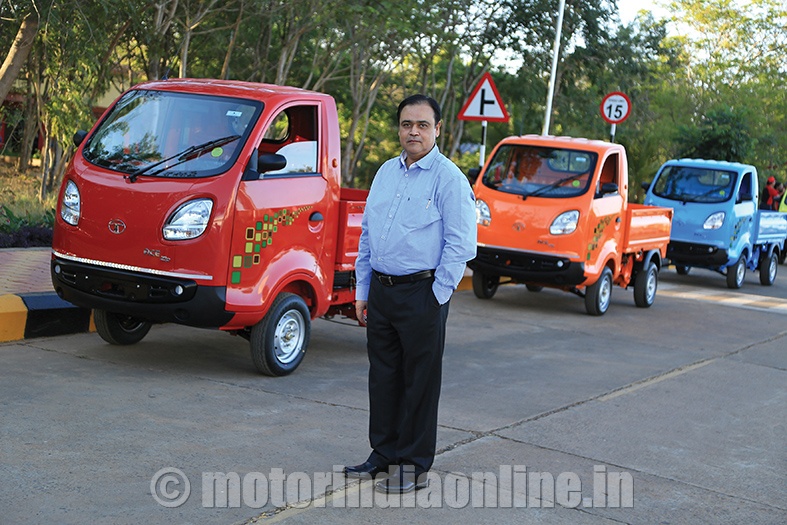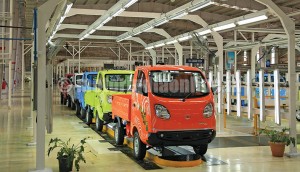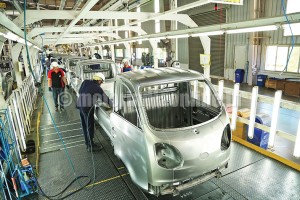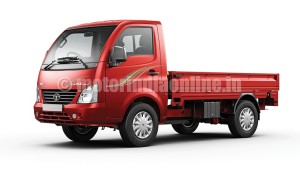
Exactly a decade ago, in 2005, India’s first mini-truck, the Tata Ace, was unveiled. Though it came from the market leader Tata Motors’ stable, the company was a new entrant in the small commercial vehicle segment which already had couple of big names with long experience in the space. The Tata Ace would go on to become a terrific success and a clear market leader in its space and not stopping there, the company has since rolled out a whole family of vehicles to build on the Ace’s success and offer a wider range of options for customers.
With a payload of 750 kg, the Ace created a new segment when it was launched and opened up exciting possibilities in terms of product variants and features, giving multiple options for customers, many of whom were buying a commercial vehicle for the first time in their lives.
In an exclusive interaction with MOTORINDIA, Mr. Sandeep Kumar, Business Head, CV – Passenger, Tata Motors Ltd., says: “When we started our Ace journey, we already had strong competition in the SCV space and we were the third player to enter the market. We knew we had to deliver a product which was superiority in terms of safety, comfort and other attributes to cater to the consumer profile. Though there was an initial resistance to the new product, we did very well which saw our market share in the SCV segment (four-wheelers) grow from 0 to 75 per cent in about a year.”
The Tata Ace created history in 2012 by crossing the one million sales-mark in just 2,680 days since market launch.
Ace Zip
With the Ace virtually sweeping the large three-wheeler segment, Tata Motors sensed the high probability of smaller and larger variants of the product gaining similar acceptance in the market. It was in mid-2011 that the 600 kg-payload Ace Zip made its market entry. The product complemented the Ace very well, giving customers the power of choice.
“As far as the Ace Zip is concerned, we got the product, marketing and few more aspects right as a result of which the consumer acceptance was very good. We understood the market better than others and the concept we tried to seed and sell in the market proved to be right. One main aspect was the cost especially because the segment is a highly cost-sensitive one. We introduced the Ace Zip at a cost difference of only around Rs. 25,000 to the three-wheeler load carriers, but loaded it with so many features that the operational economics was so overwhelming for customers”, recounts Mr. Kumar.
Designed and developed based on a deep understanding of market and customer requirements, the Ace Zip breezed past the 100,000 unit mark earlier this year. While the product sales has been free-flowing, it has also created scope for development in rural parts of the country with many customers being first time vehicle buyers. The development in rural India has been instrumental in driving product sales while the reverse could also be considered true to an extent.
“About 35 per cent of our Ace Zip customers are from rural India and a similar per cent are repeat buyers which shows the confidence and trust they have reposed on the product. Deeper penetration of the hub-and-spoke model, increased expenditure in rural areas by the government and shift in income from only agriculture to other industries are external factors which have contributed to the success of the Ace Zip. Another important aspect is the improvement in road connectivity in rural India – in the last 10 years over 4 lakh km of road have been laid across India and today, more than 80 per cent of our villages are covered by roads. We expect this trend to continue in the coming years and wish to sell our one millionth Ace Zip soon”, he explains.
Expanding range
In addition to the basic version of the Ace and the Ace Zip, the Ace family has the Super Ace with a 1-ton payload and the Ace Mega which has a slightly lower payload than the Super Ace. The Ace range boasts of USPs such as better power, enhanced safety, larger load body, lower fuel consumption, longer service intervals and more environment-friendly which have made it a dominant class of products in its league.
Highlighting the plusses of its wide range of models under the Ace brand, he says: “It is good for the customer because he gets more choices. Around a decade back he had only three-wheelers and pick-ups and nothing else but today he has options to suit every kind of his business. The trick lies in identifying gaps faster and better than somebody else and Tata Motors has managed to do it well.”
Tata Motors holds over one-third of the entire three-wheeler and four-wheeler market put together in the country and if we look at only four-wheelers and pick-ups, it commands over 50 per cent of the market.
Apart from the load carrier versions, Tata Motors has two passenger carrier models in the segment namely the Magic and the Magic Iris, both of which mirror the performance of their load-carrying counterparts and have a market leadership position in their respective segments.
Super Ace Mint
One of the latest additions to the Ace family is the Super Ace Mint which was launched earlier this year. The vehicle which has been positioned as a small pick-up is an important part of Tata Motors’ ambitions to bridge the gap between the SCV and UV segments which it would also strengthen the company’s already robust portfolio in the space.
“With the Super Ace Mint our intention is to get incremental growth in the segment. The product comes with attractive features and performance parameters and the response has been very encouraging till now. Apart from filling a gap in our product portfolio, it would augment and strengthen it further”, he states.
With an ability to carry both voluminous and bulk cargo with ease and an engine-transmission combination with a flat torque curve which minimizes gear shifts, the Super Ace Mint provides much faster turnaround for customers, thereby offering better profits. The vehicle, which will be sold only as a BS IV variant, comes with a common-rail engine that gives an impressive mileage of around 18 kmpl.
Growth to continue
Though the overall SCV segment is still negative when compared to the last two to three years, the quantum of dip in sales has come down in the last few months, mainly triggered by a recovery in the M&HCV segments.
With increasing rural market penetration and reasonably easy availability of financing being two fundamental contributors to the SCV segment growth, one can expect the segment to grow as long as the two are available.
As for Tata Motors, it has no plans of sitting back and enjoying its success, as it continues to work on new products to further strengthen its presence in the space. The company plans a slew of new launches in 2015 to expand its portfolio and probably take a larger share of the market than what it has today.


